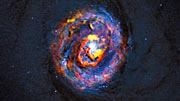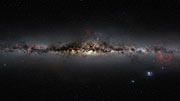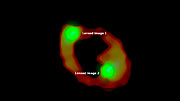Press Release
ALMA Probes Mysteries of Jets from Giant Black Holes
16 October 2013

Two international teams of astronomers have used the power of the Atacama Large Millimeter/submillimeter Array (ALMA) to focus on jets from the huge black holes at the centres of galaxies and observe how they affect their surroundings. They have respectively obtained the best view yet of the molecular gas around a nearby, quiet black hole and caught an unexpected glimpse of the base of a powerful jet close to a distant black hole.
There are supermassive black holes — with masses up to several billion solar masses — at the hearts of almost all galaxies in the Universe, including our own galaxy, the Milky Way. In the remote past, these bizarre objects were very active, swallowing enormous quantities of matter from their surroundings, shining with dazzling brilliance, and expelling tiny fractions of this matter through extremely powerful jets. In the current Universe, most supermassive black holes are much less active than they were in their youth, but the interplay between jets and their surroundings is still shaping galaxy evolution.
Two new studies, both published today in the journal Astronomy & Astrophysics, used ALMA to probe black hole jets at very different scales: a nearby and relatively quiet black hole in the galaxy NGC 1433 and a very distant and active object called PKS 1830-211.
"ALMA has revealed a surprising spiral structure in the molecular gas close to the centre of NGC 1433," says Françoise Combes (Observatoire de Paris, France), who is the lead author of the first paper. "This explains how the material is flowing in to fuel the black hole. With the sharp new observations from ALMA, we have discovered a jet of material flowing away from the black hole, extending for only 150 light-years. This is the smallest such molecular outflow ever observed in an external galaxy."
The discovery of this outflow, which is being dragged along by the jet from the central black hole, shows how such jets can stop star formation and regulate the growth of the central bulges of galaxies [1].
In PKS 1830-211, Ivan Martí-Vidal (Chalmers University of Technology, Onsala Space Observatory, Onsala, Sweden) and his team also observed a supermassive black hole with a jet, but a much brighter and more active one in the early Universe [2]. It is unusual because its brilliant light passes a massive intervening galaxy on its way to Earth, and is split into two images by gravitational lensing [3].
From time to time, supermassive black holes suddenly swallow a huge amount of mass [4], which increases the power of the jet and boosts the radiation up to the very highest energies. And now ALMA has, by chance, caught one of these events as it happens in PKS 1830-211.
"The ALMA observation of this case of black hole indigestion has been completely serendipitous. We were observing PKS 1830-211 for another purpose, and then we spotted subtle changes of colour and intensity among the images of the gravitational lens. A very careful look at this unexpected behaviour led us to the conclusion that we were observing, just by a very lucky chance, right at the time when fresh new matter entered into the jet base of the black hole," says Sebastien Muller, a co-author of the second paper.
The team also looked to see whether this violent event had been picked up with other telescopes and were surprised to find a very clear signal in gamma rays, thanks to monitoring observations with NASA's Fermi Gamma-ray Space Telescope. The process that caused the increase of radiation at ALMA’s long wavelengths was also responsible of boosting the light in the jet dramatically, up to the highest energies in the Universe [5].
"This is the first time that such a clear connection between gamma rays and submillimetre radio waves has been established as coming from the real base of a black hole's jet," adds Sebastien Muller.
The two new observations are just the start of ALMA's investigations into the workings of jets from supermassive black holes, near and far. Combes’s team is already studying other nearby active galaxies with ALMA and the unique object PKS 1830-211 is expected to be the focus of much future research with ALMA and other telescopes.
"There is still a lot to be learned about how black holes can create these huge energetic jets of matter and radiation," concludes Ivan Martí-Vidal. “But the new results, obtained even before ALMA was completed, show that it is a uniquely powerful tool for probing these jets — and the discoveries are just beginning!"
Notes
[1] This process, called feedback, may explain the mysterious relationship between the mass of a black hole at the centre of a galaxy and the mass of the surrounding bulge. The black hole accretes gas and grows more active, but then produces jets that clear out gas from the surrounding regions and stop star formation.
[2] PKS 1830-211 has a redshift of 2.5, meaning that its light had to travel for about 11 billion years before reaching us. The light we see was emitted when the Universe was just 20% of its current age. By comparison the light from NGC 1433 takes only about 30 million years to reach the Earth, a very short time in galactic terms.
[3] Einstein’s theory of general relativity predicts that light rays will be deflected as they pass a massive object such as a galaxy. This effect is called gravitational lensing and, since the first find in 1979, numerous such gravitational lenses have been discovered. The lensing can create multiple images as well as distort and magnify the background light sources.
[4] The infalling material could be a star or a molecular cloud. Such an infalling cloud has been observed at the centre of the Milky Way (eso1151, eso1332).
[5] This energy is emitted as gamma rays, the shortest wavelength and highest energy form of electromagnetic radiation.
More information
The Atacama Large Millimeter/submillimeter Array (ALMA), an international astronomy facility, is a partnership of Europe, North America and East Asia in cooperation with the Republic of Chile. ALMA is funded in Europe by the European Southern Observatory (ESO), in North America by the U.S. National Science Foundation (NSF) in cooperation with the National Research Council of Canada (NRC) and the National Science Council of Taiwan (NSC) and in East Asia by the National Institutes of Natural Sciences (NINS) of Japan in cooperation with the Academia Sinica (AS) in Taiwan. ALMA construction and operations are led on behalf of Europe by ESO, on behalf of North America by the National Radio Astronomy Observatory (NRAO), which is managed by Associated Universities, Inc. (AUI) and on behalf of East Asia by the National Astronomical Observatory of Japan (NAOJ). The Joint ALMA Observatory (JAO) provides the unified leadership and management of the construction, commissioning and operation of ALMA.
These research projects are presented in two papers, “ALMA observations of feeding and feedback in nearby Seyfert galaxies: an AGN-driven outflow in NGC1433”, by F. Combes et al. and “Probing the jet base of the blazar PKS 1830−211 from the chromatic variability of its lensed images: Serendipitous ALMA observations of a strong gamma-ray flare”, by I. Martí-Vidal et al. Both papers are appeared in the journal Astronomy & Astrophysics.
The first team is composed of F. Combes (Observatoire de Paris, France), S. García-Burillo (Observatorio de Madrid, Spain), V. Casasola (INAF–Istituto di Radioastronomia, Bologna, Italy), L. Hunt (INAF–Osservatorio Astrofisico di Arcetri, Florence, Italy), M. Krips (IRAM, Saint Martin d’Hère, France), A. J. Baker (Rutgers, the State University of New Jersey, Piscataway, USA), F. Boone (CNRS, IRAP, Toulouse, France), A. Eckart (Universität zu Köln, Germany), I. Marquez (Instituto de Astrofísica de Andalucía, Granada, Spain), R. Neri (IRAM), E. Schinnerer (Max-Planck-Institut für Astronomie, Heidelberg, Germany) and L. J. Tacconi (Max-Planck-Institut für extraterrestrische Physik, Garching bei München, Germany).
The second team is composed of I. Martí-Vidal (Chalmers University of Technology, Onsala Space Observatory, Onsala, Sweden), S. Muller (Onsala), F. Combes (Observatoire de Paris, France), S. Aalto (Onsala), A. Beelen (Institut d’Astrophysique Spatiale, Université Paris-Sud, France), J. Darling (University of Colorado, Boulder, USA), M. Guélin (IRAM, Saint Martin d’Hère, France; Ecole Normale Supérieure/LERMA, Paris, France), C. Henkel (Max-Planck-Institut für Radioastronomie [MPIfR], Bonn, Germany; King Abdulaziz University, Jeddah, Saudi Arabia), C. Horellou (Onsala), J. M. Marcaide (Universitat de València, Spain), S. Martín (ESO, Santiago, Chile), K. M. Menten (MPIfR), Dinh-V-Trung (Vietnam Academy of Science and Technology, Hanoi, Vietnam) and M. Zwaan (ESO, Garching, Germany).
ESO is the foremost intergovernmental astronomy organisation in Europe and the world’s most productive ground-based astronomical observatory by far. It is supported by 15 countries: Austria, Belgium, Brazil, Czechia, Denmark, France, Finland, Germany, Italy, the Netherlands, Portugal, Spain, Sweden, Switzerland and the United Kingdom. ESO carries out an ambitious programme focused on the design, construction and operation of powerful ground-based observing facilities enabling astronomers to make important scientific discoveries. ESO also plays a leading role in promoting and organising cooperation in astronomical research. ESO operates three unique world-class observing sites in Chile: La Silla, Paranal and Chajnantor. At Paranal, ESO operates the Very Large Telescope, the world’s most advanced visible-light astronomical observatory and two survey telescopes. VISTA works in the infrared and is the world’s largest survey telescope and the VLT Survey Telescope is the largest telescope designed to exclusively survey the skies in visible light. ESO is the European partner of a revolutionary astronomical telescope ALMA, the largest astronomical project in existence. ESO is currently planning the 39-metre European Extremely Large optical/near-infrared Telescope, the E-ELT, which will become "the world’s biggest eye on the sky".
Links
- Research papers: Combes et al. & Marti-Vidal et al.
- Video showing cosmic indigestion in the remote supermassive black hole PKS 1830-211, as seen by ALMA
- Photos of the ALMA array
Contacts
Françoise Combes
Observatoire de Paris, LERMA
Paris, France
Tel: +33 1 4051 2077
Email: francoise.combes@obspm.fr
Ivan Martí-Vidal
Chalmers University of Technology
Onsala Space Observatory, Onsala, Sweden
Tel: +46 31 772 5557
Email: ivan.marti-vidal@chalmers.se
Richard Hook
ESO, Public Information Officer
Garching bei München, Germany
Tel: +49 89 3200 6655
Cell: +49 151 1537 3591
Email: rhook@eso.org
About the Release
| Release No.: | eso1344 |
| Name: | NGC 1433 |
| Type: | Local Universe : Galaxy |
| Facility: | Atacama Large Millimeter/submillimeter Array |
| Science data: | 2013A&A...558A.124C 2013A&A...558A.123M |
Our use of Cookies
We use cookies that are essential for accessing our websites and using our services. We also use cookies to analyse, measure and improve our websites’ performance, to enable content sharing via social media and to display media content hosted on third-party platforms.
ESO Cookies Policy
The European Organisation for Astronomical Research in the Southern Hemisphere (ESO) is the pre-eminent intergovernmental science and technology organisation in astronomy. It carries out an ambitious programme focused on the design, construction and operation of powerful ground-based observing facilities for astronomy.
This Cookies Policy is intended to provide clarity by outlining the cookies used on the ESO public websites, their functions, the options you have for controlling them, and the ways you can contact us for additional details.
What are cookies?
Cookies are small pieces of data stored on your device by websites you visit. They serve various purposes, such as remembering login credentials and preferences and enhance your browsing experience.
Categories of cookies we use
Essential cookies (always active): These cookies are strictly necessary for the proper functioning of our website. Without these cookies, the website cannot operate correctly, and certain services, such as logging in or accessing secure areas, may not be available; because they are essential for the website’s operation, they cannot be disabled.
Functional Cookies: These cookies enhance your browsing experience by enabling additional features and personalization, such as remembering your preferences and settings. While not strictly necessary for the website to function, they improve usability and convenience; these cookies are only placed if you provide your consent.
Analytics cookies: These cookies collect information about how visitors interact with our website, such as which pages are visited most often and how users navigate the site. This data helps us improve website performance, optimize content, and enhance the user experience; these cookies are only placed if you provide your consent. We use the following analytics cookies.
Matomo Cookies:
This website uses Matomo (formerly Piwik), an open source software which enables the statistical analysis of website visits. Matomo uses cookies (text files) which are saved on your computer and which allow us to analyze how you use our website. The website user information generated by the cookies will only be saved on the servers of our IT Department. We use this information to analyze www.eso.org visits and to prepare reports on website activities. These data will not be disclosed to third parties.
On behalf of ESO, Matomo will use this information for the purpose of evaluating your use of the website, compiling reports on website activity and providing other services relating to website activity and internet usage.
Matomo cookies settings:
Additional Third-party cookies on ESO websites: some of our pages display content from external providers, e.g. YouTube.
Such third-party services are outside of ESO control and may, at any time, change their terms of service, use of cookies, etc.
YouTube: Some videos on the ESO website are embedded from ESO’s official YouTube channel. We have enabled YouTube’s privacy-enhanced mode, meaning that no cookies are set unless the user actively clicks on the video to play it. Additionally, in this mode, YouTube does not store any personally identifiable cookie data for embedded video playbacks. For more details, please refer to YouTube’s embedding videos information page.
Cookies can also be classified based on the following elements.
Regarding the domain, there are:
- First-party cookies, set by the website you are currently visiting. They are stored by the same domain that you are browsing and are used to enhance your experience on that site;
- Third-party cookies, set by a domain other than the one you are currently visiting.
As for their duration, cookies can be:
- Browser-session cookies, which are deleted when the user closes the browser;
- Stored cookies, which stay on the user's device for a predetermined period of time.
How to manage cookies
Cookie settings: You can modify your cookie choices for the ESO webpages at any time by clicking on the link Cookie settings at the bottom of any page.
In your browser: If you wish to delete cookies or instruct your browser to delete or block cookies by default, please visit the help pages of your browser:
Please be aware that if you delete or decline cookies, certain functionalities of our website may be not be available and your browsing experience may be affected.
You can set most browsers to prevent any cookies being placed on your device, but you may then have to manually adjust some preferences every time you visit a site/page. And some services and functionalities may not work properly at all (e.g. profile logging-in, shop check out).
Updates to the ESO Cookies Policy
The ESO Cookies Policy may be subject to future updates, which will be made available on this page.
Additional information
For any queries related to cookies, please contact: pdprATesoDOTorg.
As ESO public webpages are managed by our Department of Communication, your questions will be dealt with the support of the said Department.









